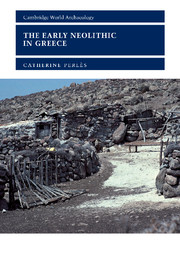Book contents
- Frontmatter
- Contents
- List of figures
- List of tables
- Acknowledgements
- Introduction
- 1 The land and its resources: the geographic context
- 2 The Mesolithic background
- 3 The introduction of farming: local processes, diffusion or colonization?
- 4 Foreign colonists: where from?
- 5 The earliest Neolithic deposits: ‘aceramic’, ‘pre-pottery’ or ‘ceramic’?
- 6 The spread of the Early Neolithic in Greece: chronological and geographical aspects
- 7 A case study in Early Neolithic settlement patterns: eastern Thessaly
- 8 Early Neolithic subsistence economy: the domestic and the wild
- 9 The Early Neolithic village
- 10 Craft specialization: the contrasting cases of chipped-stone tools, pottery and ornaments
- 11 A variety of daily crafts
- 12 Ritual interaction? The miniature world of ‘dolls or deities’
- 13 Interacting with the dead: from the disposal of the body to funerary rituals
- 14 Interactions among the living
- Conclusion
- Bibliography
- Index
13 - Interacting with the dead: from the disposal of the body to funerary rituals
Published online by Cambridge University Press: 18 December 2009
- Frontmatter
- Contents
- List of figures
- List of tables
- Acknowledgements
- Introduction
- 1 The land and its resources: the geographic context
- 2 The Mesolithic background
- 3 The introduction of farming: local processes, diffusion or colonization?
- 4 Foreign colonists: where from?
- 5 The earliest Neolithic deposits: ‘aceramic’, ‘pre-pottery’ or ‘ceramic’?
- 6 The spread of the Early Neolithic in Greece: chronological and geographical aspects
- 7 A case study in Early Neolithic settlement patterns: eastern Thessaly
- 8 Early Neolithic subsistence economy: the domestic and the wild
- 9 The Early Neolithic village
- 10 Craft specialization: the contrasting cases of chipped-stone tools, pottery and ornaments
- 11 A variety of daily crafts
- 12 Ritual interaction? The miniature world of ‘dolls or deities’
- 13 Interacting with the dead: from the disposal of the body to funerary rituals
- 14 Interactions among the living
- Conclusion
- Bibliography
- Index
Summary
All societies have to deal with the practical, psychological and social problems created by death. The responses vary widely and depend as much on beliefs as on the organization of the living society. A primary reading of the available data on EN funerary customs reveals a pattern shared with the Balkans: no organized necropolises, no conspicuous monuments, but a variety of ‘domestic’ funerary rituals comprising primary burials in pits, secondary burials, cremations and bone scatters. The interpretations have converged in pointing out the lack of sophistication and ‘simplicity’ of the funerary rituals, the latter being, in turn, considered as the expression of a simple, ‘egalitarian’ society (cf. Demoule and Perlès 1993; Gallis 1996a; Hourmouziadis 1973b). Yet, I shall now argue that we have all been misled in our reading of the data: we have considered the exception to be the rule.
More than twenty years ago, Hourmouziadis already pointed out that the populations of the large settlements of Sesklo and Dimini had obviously been disposed of in unexcavated cemeteries or outside the settlements. No burial had been uncovered, despite the vast areas covered by the excavations (Hourmouziadis 1973b: 209–10). Since then, only one burial, of EN1 date, has been found at Sesklo: that of an adult, in sector C below the Acropolis (Theocharis 1977: 88–93). More generally, the sample of Early Neolithic burials has remained extremely meagre in spite of further excavations and the discovery of several cremations at Soufli (Gallis 1975, 1982).
- Type
- Chapter
- Information
- The Early Neolithic in GreeceThe First Farming Communities in Europe, pp. 273 - 282Publisher: Cambridge University PressPrint publication year: 2001



